Twill Weave is the 2nd basic weave pattern that produces lines on the face of the fabric. In this article we will discuss twill weave fabric structure and design.
What is Twill Weave?
Definition: A weave that repeats on three or more ends and picks produces diagonal lines on the face of the fabric. The order of interlacing that creates a diagonal line of Warp and weft floats to be formed in the fabric is called twill weave.
Appearance of twill weave
A twill weave is characterized by diagonal ribs (twill lines) on the face of the fabric. These twill lines are produce by letting all warp ends interlace in the same way but displacing the interlacing points of each end by one pick relative to that of the previous end while the plain weave derivatives can only be woven in one form, there exit several options with regard to twills.
Read More: Difference Plain, Twill, Satin Weave
Twill Weave Characteristics
The characteristics of twill weave are as follows:
- Produce diagonal lines from one selvage to another.
- Smallest repeat size 3*3.
- At least 3 heald shafts are required.
- Generally, the straight draft is used (V draft/ Pointed draft, Broken draft).
- Draft multiple of 2 or 3.
- Both sides are face sides, but their appearance is different.
- Textured and Strong weave.
- Less binding point than plain cloth.
- More ends per unit area & picks per unit area than plain cloth.
- More cloth thickness & mass per unit area.
- More pliable.
- Better wrinkle recovery.
- Better cover thickness.
Classification of Twill Weave:
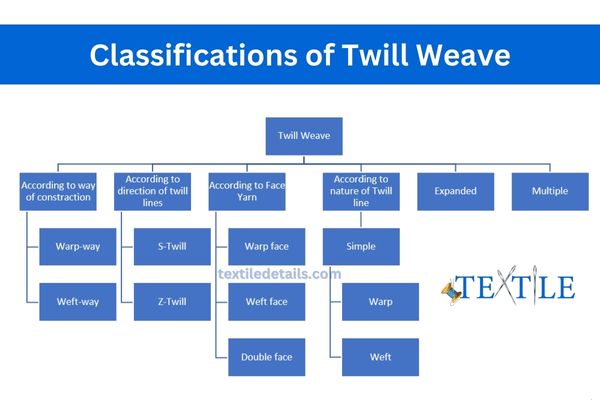
1. Directions
a) Warp-way twill: warp float run in the warp direction.
b) Weft-way twill: weft float run in the weft direction.
2. According to direction of twill line
a) S-twill/Left hand Twill: Twill line (Diagonal line) runs from the lower right corner to the upper left corner. Exp: 3/2 S, 2/2 S, 2/3 S etc.
b) Z-twill/Left hand Twill: Twill line (Diagonal line) runs from the lower left corner to the upper right corner.
Exp: 3/2 z, 2/2 z, 2/3 z etc.
3. According to Face Yarn
a) Warp-face Twill: A predominance of warp yarns is seen on the face of the fabric.
Exp: 2/1, 3/1, 4/1 twill weave, 3/2 etc. [Warp up > Warp Down]
b) Warp-face Twill: A predominance of warp yarns is seen on the face of the fabric.
Exp: 1/2, 1/3, 2/3 etc. [Warp up < Warp Down]
c) Double face Twill/ Even-sided Twill: Predominance of warp & weft yarns on both sides of the fabric. [Warp up = Warp Down]
Exp: 2/2, 3/3, 4/4
4. According to Nature of Twill
a) Simple Twill:
Each warp end is raised over or lowered under only one pick in the repeat.
Exp: 2/1, 3/1, 1/2, 1/3 etc.
i) Simple Warp Twill: Each warp end is lowered under only one pick in the repeat. (Warp up > 1, Warp Down = 1)
Exp- 2/1, 3/1 etc.
ii) Simple Weft Twill: Each warp end is raised over only one pick in the repeat. (Warp up. =1, Warp Down >1)
Exp: 1/2,1/3 etc…
b) Expanded Twill:
Each warp end is raised over or lowered under more than one adjacent pick in the repeat. (Both warp up & map down will be more than 1)
Exp- 3/2,2/3,3/3 etc.
c) Multiple Twill:
It contains at least two warp twill lines or two weft twill lines of different widths in each repeat,
Exp- 3 4 8/ 2 3 2, 5 6 8/ 2 3 9
Factors affect prominence of twill weave
a. Character of weave
- Twill line of short float – less prominence.
- Twill line of long float – more prominence.
b. The character of yarn-
- Twill line of coarse and soft twisted yarn-More prominence.
- Twill line of fine and hard twisted yarn-less prominence.
- Folded and ply yarn- more prominence.
- Single yarn- less prominence.
c. No. of ends and picks per inch
- More no. of ends and picks per inch-more prominence
- Less no. of ends and picks per inch-less prominence
d. The direction of twill in relation to the direction of twist in the yarn
- Twist direction of yarn and twill weave move in opposite directions- More prominence
- Twist direction of yarn and twill weave move in the same direction- less prominence
Derivatives of Twill Weave
There are 8 twill weave derivatives. They are as:
- Zig-zag Twill
- Herringbone Twill
- Diamond Design
- Diaper Design
- Broken/ Reversed Twill
- Re-arranged/ Transposed Twill
- Stepped Twill
- Elongated/ Step Twill
- Combined Twill
- Shaded Twill
1. ZigZag/ Waved/ Pointed Twill:
Zigzag till is one of the most important modifications of twill weave produced by reversing the direction of the twill at a suitable interval and combination of ‘s’ and ‘z’
twill. According to reversing of direction, two types of zig-zag twill are formed.
After the basic Twill, the direction of the twill will reverse. That is, if the regular repeat size is 4*4, then “1234” after “3214” in design.
(i) Horizontal zig-zag
(ii) vertical zig-zag
i) Horizontal ZigZag Twill:
Formula number: 3/2 Z
Repeat number: (10*5)
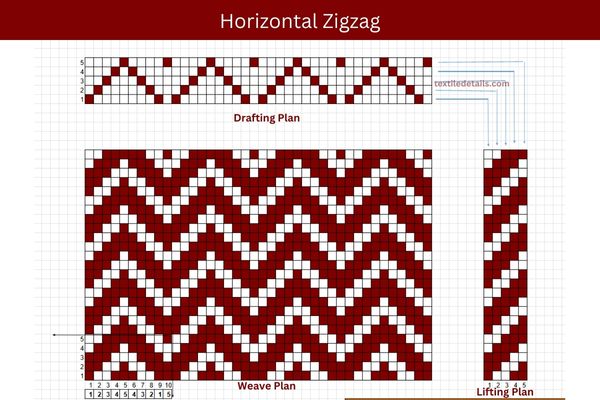
- Basic twill runs along the warp.
- Twill direction reverses upon the warp.
- No. of warp yarn is double the no. of weft yarn in the repeat.
- The change of direction starts when finished basic twill repeat and makes the point in the moment of change.
- Pointed/ v-draft is used
- This can be made from any continuous twill.

After the basic Twill, the direction of the twill will reverse towards the warp. That is, Formula No. If 3/2, Needs to put 12345 43215 design on the warp side. In that case, the repeat size of 5*5 regular repeat size is 10*5.
Let’s see some more examples:
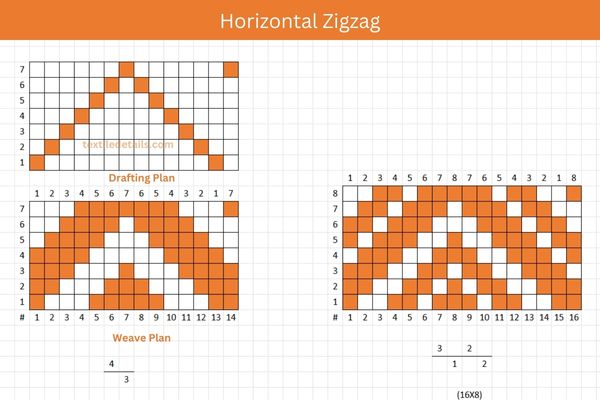
ii) Vertical ZigZag Twill:
Formula number: 3/2 Z
Repeat number: (5*10)
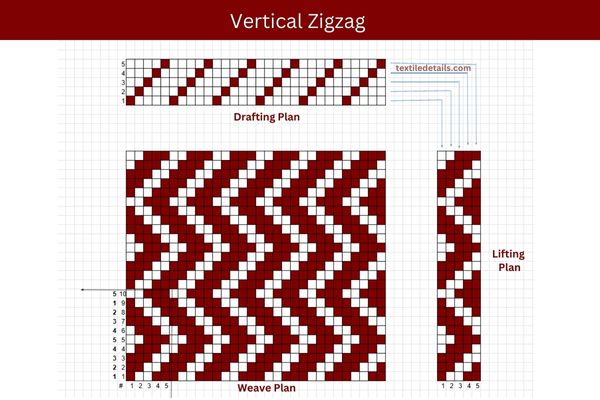
- Basic twill runs along the weft.
- Twill direction reverses upon the weft.
- No. of weft yarn is double to the no. of warp yarn in the repeat.
- The change of direction starts when finished basic twill repeat and makes point in the moment of change.
- The straight draft is used
- This can be made from any continuous twill.

After the basic twill, the direction of the twill will reverse towards the waft. That is, Formula No. If 3/2, I will put 12345 43215 design on the warp side. In that case, the repeat size of 5*5 regular repeat size is 5*10
2. Herringbone Twill:
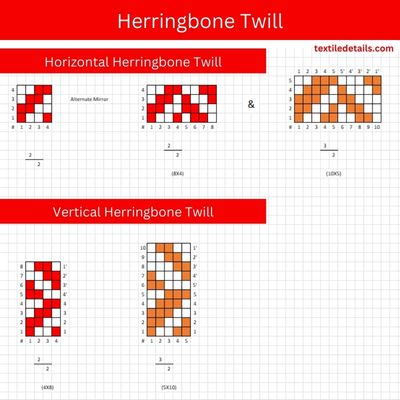
- This twill is produced by the reversal of twill direction at a suitable interval but not as a zig-zag twill.
- Changing of direction of the warp and weft yarns.
- The floating condition is reversed of the previous yarn.
- It is also the combination of ‘z’ and ‘s’ twill.
After the basic twill, the direction of the twill will reverse. But not like Zig-zag Twill. That is, if the regular repeat size is 4*4, I will put 1234 4’3’2’1′ in the design.
Types:
i. Horizontal Herringbone twill
ii. Vertical Herringbone twill
i. Horizontal Herringbone Twill:
Formula number: 4/3 Z
Repeat number: (14*7)

1. Twill direction reverses upon the warp yarn on the
principle of Herring bone twill.
2. No. of warp yarn is double to the no. of weft in the
repeat.
3. Basic twill runs along warp.
4. Broken or straight draft is used.
5. Horizontal stripe effect formed in the fabric.
Have to use the Herringbone design principle towards the waft. That is, if the regular repeat size is 4*4, I will put 1234 4’3’2’1′ on the warp side.
ii. Vertical Herringbone Twill:
Formula number: 4/3 Z
Repeat number: (14*7)
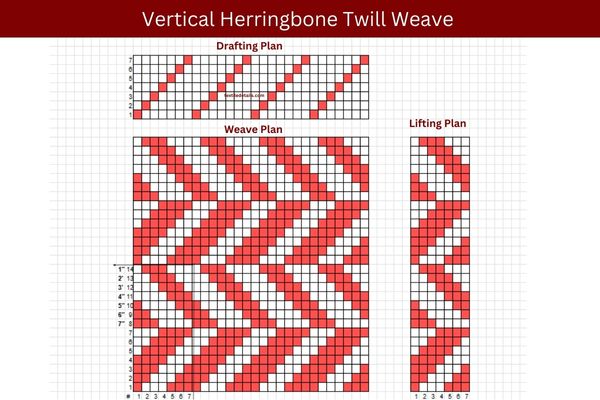
- Twill direction reverses upon the weft yarn on the principle of Herring bone twill.
- No. of weft yarn is double to the no. of warp in the repeat.
- Basic twill runs along warp.
- straight draft is used.
- Vertical stripe effect formed in the fabric.
I will use the Herringbone design principle towards the waft. That is, if the regular repeat size is 4*4, we will set 1234 4’3’2’1′ towards the weft.
3. Diamond Design:
Diamond weave pattern is one of the most popular twill weave design used in woven fabric.
- Formula number: 4/3 Z
- Repeat number: (14*14)

- It is constructed 0n the principle of Zig-zag twill.
- It is found by the combination of horizontal and vertical Zig-zag twill.
- No. of both warp and weft threads are double than that of the base twill in the repeat.
- Pointed draft is used.
- Diamond designs are symmetrical about their horizontal and vertical axis.
- It can be divided into two equal parts along horizontal and vertical axis.
Formula number: 3/3 Z
Repeat number: (12*12)

These designs are created by combining horizontal and vertical zigzag. In this case, if the regular repeat size is (3*3), the repeat size of Diamond design will be (12*12).
4. Diaper Design:
Formula number: 4/2 Z
Repeat number: (12*12)

- It is constructed 0n the principle of herring bone twill.
- It is found by the combination of horizontal and vertical herring bone twill.
- No. of both warp and weft threads are double than that of the base twill in the repeat.
- Straight or broken draft is used.
- Diaper designs are symmetrical about their diagonal axis.
- It can be divided into two equal parts along diagonal axis.
Formula number: 3/3 Z
Repeat number: (12*12)
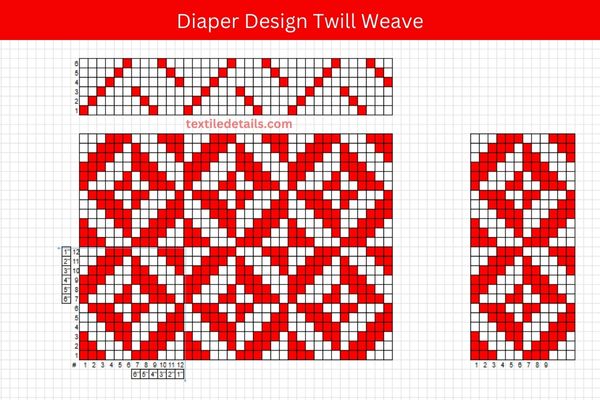
These designs are created by combining horizontal and vertical zigzag.
5. Broken/ Reversed Twill:
Formula number: 3/3 Z
Repeat number: (6*6)

- It is obtained by breaking the twill line of a basic or regular twill.
- It is some how similar in appearance to zig-zag twill.
- A large variety of attractive effects can be produced by this twill.
- It is formed by dividing the basic twill repeat in two, three, four or more groups.
- Straight draft is used.
Types:
(i) Warp way
(ii) Weft way

After the basic twill line, divide the twill line into 2 or more parts and keep one part unchanged and reverse the other part. That is, if the repeat size of basic twill is (2/3), I will design 12345 67810. If repeat size of basic twill is 12345 10’9’8’7’6′ (5*5) then I will design 12345678910.
5. Re-arranged/ Transposed Twill:
- It is produced by the rearrangement of the original order of threads in the regular basic twill.
- This rearrangement may interrupt the continuation of twill
line and give the effect of a broken twill design.
This twill can be constructed-
(i) By rearranging the yarns individually.
(ii) By rearranging the yarns group wise.
(iii) By cork-screw weave-
(a) Odd no. cork-screw weave.
(b) Even no. cork-screw weave.
(i) Rearranged of Individual threads:
Warp or weft will be arranged by reversing the design on either side so that there is no consecutive design.
Formula number: (4) 2/(2) 1
Repeat number: (9*9)
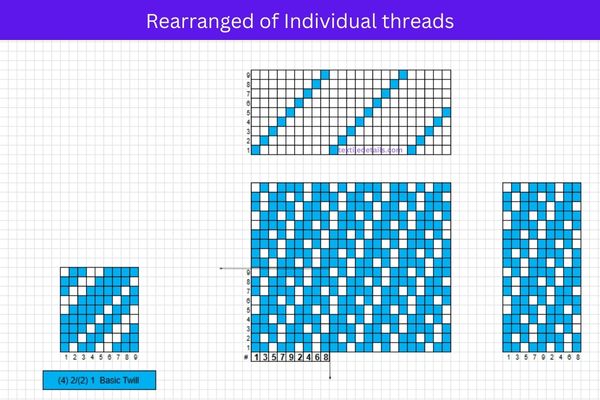
(ii) Re-arrangement of groups of threads:
Divide the basic twill design into several groups and interchange them so that there is no consecutive design.
Formula number: (4) 2/(2) 1
Repeat number: (9*9)

(iii) Corkscrew Weave:
a) Odd No. Corkscrew:
Move No. like satin weave. This design is made using At first move no. After using warp up, I will start the up-down grace of each warp from there.
b) Even No. Corkscrew:
I will mix 2 designs of same repeat size. Any design will be started from the beginning and another design will be divided into two and the last one will sit first.
7. Stepped Twill:
Stepped twill is produced by stepping a continuous twill and keeping the direction of twill line same or opposite.
Types:
a. Warp way step
b.Weft way step
c. Both warp and weft step
a. Warp-way step:
Formula number: 2/2 Z
Repeat size 16*4
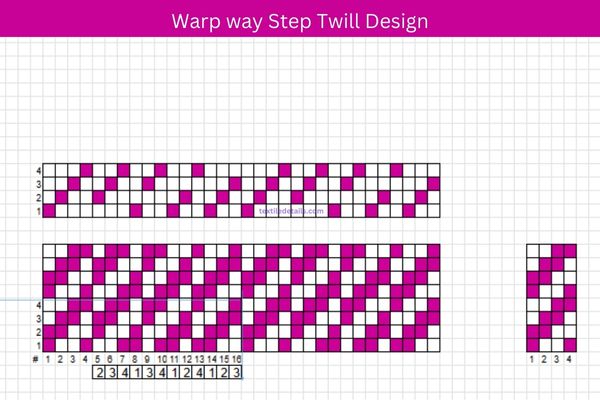
i) Same Twill Direction: At the end of the repeat of basic twill or after any warp, the next warp will have a “step” meaning the reverse design of the previous warp (up->down, down->up). Next warp design will continue according to the rules of twill. This will continue until the basic twill repeat.
ii) Reverse Twill Direction: Same as ‘’Horizontal Herringbone Twill’’
b. Weft-way Step:
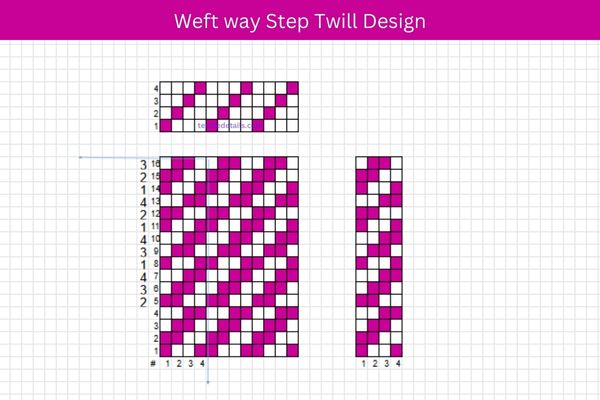
i) Same Twill Direction: Have to apply the rules of warp way step to weft instead of warp.
ii)Reverse Twill Direction: Same as ‘’ Vertical Herringbone Twill’.
c. Both warp & weft way step: Same as ‘ Diaper Design’
8. Elongated:
The twill which is produced by twill angle is less than or more than 45 degree respect to horizontal or vertical axis is called Elongated twill.
tan α = Rate of advancement of twill upwards/ Rate of advancement of twill outwards * Ends per cm/ Picks per cm.
a. Warp-way Elongation:
The angle will increase towards the warp, i.e. leave 1 cell and write design (1 followed by 3, then 5, 7… like this.
i) Odd No. warp-way Elongation:
Formula number: (4) 2/ (2) 1 Z
Repeat size 9*9
When Basic R.S is ODD

From Warp No. 1, I will exclude 5 houses and write design. I will write the excluded design. If you want, you can also start from Warp.
ii) Even No. Warp-way Elongation:
Formula number: (4) 2/ (2) 2 Z
Repeat size 5*10
When Basic R.S is Even

From Warp No. 1, I will exclude 5 houses and write design. You do not have to enter the excluded design. We can also start from WARP if we want.
b. Weft-way Elongation:
The angle will increase towards the weft
i) Odd No. Weft-way Elongation:
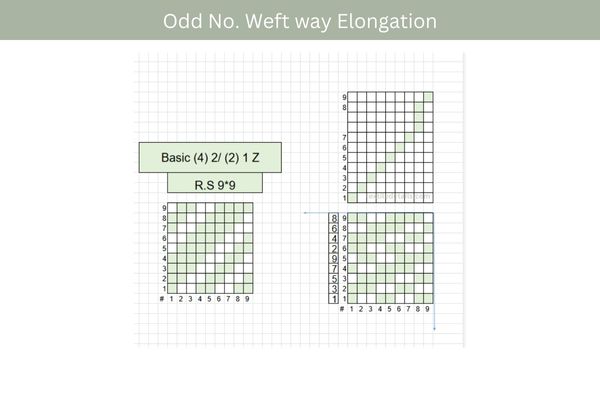
From Warp No. 1, I will exclude 5 houses and write design. I will write the design of the design. If you want, I can start from Warp.
ii) Even No. Weft-way Elongation:
Formula number: (4) 2/ (2) 2 Z
Repeat size 10*5
When Basic R.S is Even
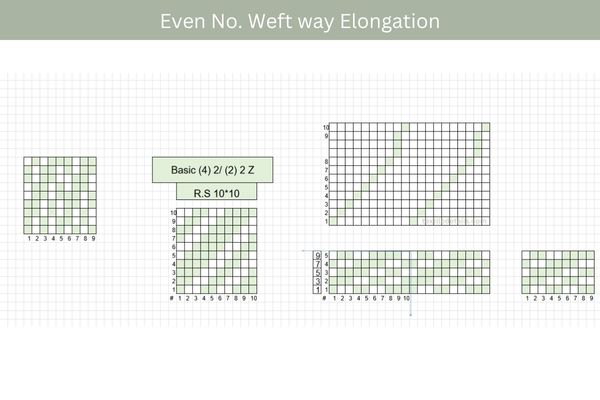
From Warp No. 1, I will exclude 5 houses and write design. You do not have to enter the excluded design. We can also start from Weft if we want.
9. Combined Twill:
- It is formed for different types of new design.
- It is formed by combination of two continuous twill.
- No practically limitations and varieties of design can be formed.
- It is capable of producing compact and firm textures.
- It may be both of warp and weft face.
- In warp way combined twill divided draft and weft way
straight draft.
This design is made by combining two twill weaves of the same or different repeat size.
i. Warp-way Combination:
Repeat size 24*12
Basic warp twill 2/2 & 3/3
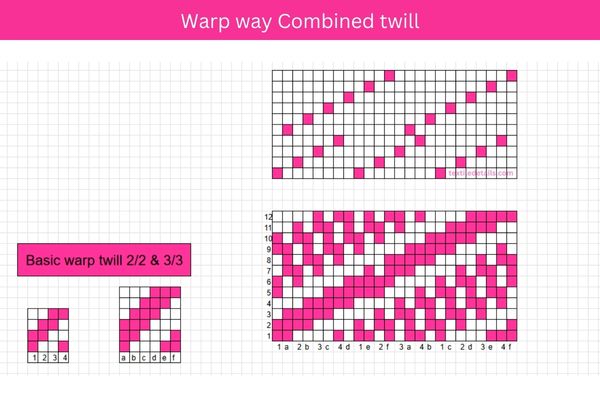
ii. Weft way Combination:

This design is created by mixing two twill weave towards Weft.
10. Shaded Twill:
a. Single shaded:
Formula N. 3 2 1/ 1 2 3
Repeat Size 12*12
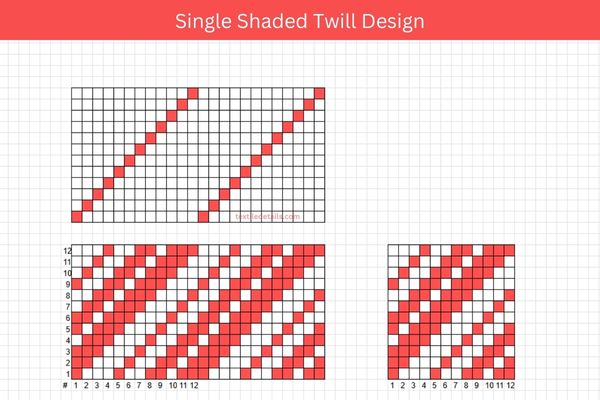
Multiple will twill. In this case the warp up gradually decrease is Warp Down Gradually record.
b. Double Shaded
1 2 3 4 5 5 4 3 2
——————–
5 4 3 2 1 2 3 4 5
Figuring with extra threads
A distinguishing features of fabrics in which extra materials are employed is that the with drawl of the extra threads from the cloth leaves a complete ground structure under the figure.
Extra threads:
For producing various types of design on fabric an extra threads set of warp or weft is used.
Methods of using extra threads
1. Extra warp threads
2. Extra weft threads
3. Both extra warp and weft design
Extra warp design
Check and stripe weave
Stripe and check designs result from the combination, in equal or unequal spaces, of two, three or more weaves that are suitable for combining in stripe form can very frequently be combined also in check form.
Crepe weave
The characteristic feature of crepe fabrics is one of texture. Their surface exhibits an allover, random, small-scale pattern in low relief. There are two ways of obtaining this kind of texture:
By using a special ‘crepe’ or ‘oatmeal’ weave in conjunction with ordinary, normal-twist spun or filament yarns, and High-twist crepe yarns in conjunction with plain or other simple weaves such as twill or satin.
The characteristics of crepe-weave fabrics depend largely upon the kind of yarn used.
If ordinary yarns are used and the crepe weave is employed to give a crepe appearance, then the fabric will have little drapability, low strength, and limited durability. Some crepe fabrics tend to stretch, and some may shrink when subjected to wetting.
On the other hand, combinations of yarns and weave construction can produce fabrics of interesting appearance and texture that have good drapeability, resilience, stretch, and serviceability.
There are 4 basic methods of producing crepe weaves:
a. On a sateen base
b. By reversing
c. By superimposing
d. On a plain weave base
Drafting system of All Twill Derivatives
1. Basic plain & derivatives: Skip draft
2. Basic twill : Straight draft
3. Diamond, Zig-zag (horizontal) : Pointed draft
4. Zig-zag (Vertical) : Straight draft
5. Herringbone (Horizontal) : Broken draft
6. Herringbone (Vertical) : Straight draft
7. Diaper (Balanced) : Broken draft
8. Diaper (Not Balanced) : Straight draft
9. Broken : Straight draft
10. Rearranged : Straight draft
11. Corkscrew : Odd no : Straight draft
12. Corkscrew : Even no : Divided draft
13. Step twill : (Horizontal) : Broken draft
14. Step twill : (Vertical) : Straight draft
15. Elongated twill : Straight draft
16. Combined : Warp way : Divided draft
17. Combined : Weft way : Straight draft
18. Basic satin : Straight draft
19. Crepe : Sateen base : Straight draft
20. Crepe : Reversing : Straight draft
21. Crepe : Superimposing :
22. Crepe : Plain based : Divided draft
References:
- Understanding Merchandising – Prof. Dr. Shah Alimuzzaman
- Fabric Structure and Design – N. Gokarneshan
- https://niterians.blogspot.com/2016/06/classification-of-twill-weave_27.html
- https://textilestudycenter.com/zig-zag-and-herringbone-twill-weave/
- Akib Note AE-44 From Butex Notebot
- Shilpi Mam, Butex
- Watson’s Textile Design and Colour – Z.Grosicki
- Watson’s Advanced Textile Design and Colour – Z.Grosicki
- Woven Cloth Construction – Robinson.

Mahedi Hasan working as an Executive (Fabric Marketing) at Pengnuo Group. Graduated with B.Sc. in Textile Engineering. Before was a Top Rated content writer at Upwork, and Level 02 Seller at Fiverr, Level 02 Publisher at Ezoic. Very passionate about content writing, SEO practice, and fashion website designing. Highly Experienced fashion writer for the last 4+ years. Have extensive 7 years of experience in the wholesale clothing business.
